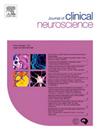Effect of epidural gelfoam soaked levobupivacaine with or without pethidine on postoperative analgesia after single-level lumbar laminectomy: Randomized controlled study
IF 1.9
4区 医学
Q3 CLINICAL NEUROLOGY
引用次数: 0
Abstract
Background
Postoperative pain following spine surgery remains a challenge for patients, surgeons and healthcare facilities. This study aimed to evaluate the postoperative analgesic efficacy of gelfoam soaked in pethidine combined with levobupivacaine, compared to gelfoam soaked in levobupivacaine alone in single-level lumbar laminectomy patients.
Methods
This was a prospective, randomized, double blinded study. A total of 90 patients of either sex, aged 18 to 60 years with ASA class I or II planned for single-level lumbar laminectomy were randomly assigned into three equal groups: group A (levobupivacaine plus pethidine): epidural gelfoam soaked with 1 ml levobupivacaine 0.25 % plus 1 ml pethidine 50 mg, group B (levobupivacaine alone): epidural gelfoam soaked with 1 ml levobupivacaine 0.25 % plus 1 ml of 0.9 % sodium chloride; and group C (control group): epidural gelfoam soaked with 2 ml of 0.9 % sodium chloride. Total analgesic consumption, time to first rescue analgesic request, time to ambulate, postoperative VAS scores, vital signs and adverse effects were recorded.
Results
Demographic and baseline patients’ data were comparable among the 3 groups. Group B had lower total analgesic consumption, prolonged time to first rescue analgesia, earlier ambulation, and lower VAS scores in the first 24 h in compared to control group C. Significant differences were found between groups A and B in total analgesic consumption, time to first rescue analgesia, and VAS score in the first 24 h. However, no significant differences were found between the two groups regarding time of ambulation and average VAS scores 24 to 48 h after surgery. There were no significant differences in the occurrence of adverse effects among the 3 groups.
Conclusions
This study demonstrated that the addition of pethidine to epidural levobupivacaine in a gelfoam soaked form enhanced the postoperative analgesia in patients undergoing single-level lumbar laminectomy in terms of reduced total analgesic consumption, prolonged time to first rescue analgesia and lower postoperative pain scores.
求助全文
约1分钟内获得全文
求助全文
来源期刊

Journal of Clinical Neuroscience
医学-临床神经学
CiteScore
4.50
自引率
0.00%
发文量
402
审稿时长
40 days
期刊介绍:
This International journal, Journal of Clinical Neuroscience, publishes articles on clinical neurosurgery and neurology and the related neurosciences such as neuro-pathology, neuro-radiology, neuro-ophthalmology and neuro-physiology.
The journal has a broad International perspective, and emphasises the advances occurring in Asia, the Pacific Rim region, Europe and North America. The Journal acts as a focus for publication of major clinical and laboratory research, as well as publishing solicited manuscripts on specific subjects from experts, case reports and other information of interest to clinicians working in the clinical neurosciences.
 求助内容:
求助内容: 应助结果提醒方式:
应助结果提醒方式:


